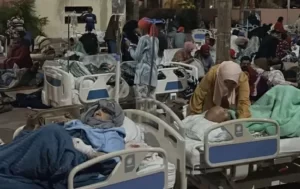
A Devastating Earthquake Struck Morocco’s:
A devastating earthquake struck Morocco’s High Atlas mountains, resulting in the loss of hundreds of lives as buildings crumbled and terrified residents fled their trembling homes in multiple cities and towns.
In the vicinity of the epicenter, Marrakech, the nearest major city, reported structural collapses in its historic old city, a designated UNESCO world heritage site. Initial reports suggested that a minaret towering over Jemaa el-Fnaa, a bustling market square and a prominent attraction for tourists, had partially collapsed, injuring two individuals. In response, local residents sought refuge in the open area of the square.
Television broadcasts depicted scenes of chaos and devastation as piles of rubble and fractured pipes crushed parked vehicles and obstructed thoroughfares throughout Marrakech. Following the earthquake, which occurred at 11:11 PM on Friday, residents flooded into the streets, apprehensive of potential aftershocks. State TV coverage showed people wrapped in blankets, forced to sleep outdoors due to their fear of further seismic activity.
Fayssal Badour, a Marrakech resident, shared his experience: “I was returning home when the earthquake struck. My car rocked back and forth, but I didn’t imagine for a single second that this meant there was an earthquake happening. I stopped, and I realized the catastrophe… it felt like we were on a river that suddenly burst its banks. The cries and shouts were unbearable.”
On Saturday morning, Moroccan television reports grimly raised the death toll to 632, with 329 people injured, citing information from the interior ministry. Earlier statements from the ministry indicated a significant number of casualties in the regions near the earthquake’s epicenter. The ministry also noted that the majority of the damage occurred outside urban areas and towns.
A local official emphasized that most of the fatalities occurred in remote, mountainous areas that posed significant challenges for rescue efforts.
 The Earth Shook For About 20 Seconds
The Earth Shook For About 20 Seconds
Hamid Afkir, a teacher residing in a mountainous region west of the epicenter near Taroudant, described the terrifying experience: “The earth shook for about 20 seconds. Doors opened and shut by themselves as I rushed downstairs from the second floor.” He also mentioned that there were subsequent aftershocks.
According to Morocco’s geophysical center, the earthquake, with a magnitude of 7.2, struck in the Ighil area. The US Geological Survey, on the other hand, reported a magnitude of 6.8 and noted that the earthquake occurred at a relatively shallow depth of 11.5 miles (18.5 km).
Ighil, a remote region characterized by its rugged terrain and dotted with small agricultural communities, lies approximately 40 miles (70 kilometers) to the southwest of Marrakech. The earthquake struck shortly past 11 PM.
Within Marrakech, numerous residences situated closely together in the historic old city bore the brunt of the devastation, with some structures collapsing entirely. Residents, lacking heavy machinery, were engaged in the painstaking task of manually removing debris, as described by local resident Id Waaziz Hassan.
Video footage captured the extent of the damage to the city’s medieval fortifications, revealing substantial fissures in one section and segments that had crumbled, resulting in a cascade of rubble onto the streets.
Another resident of Marrakech, Brahim Himmi, reported witnessing ambulances emerging from the historic city center, indicating the urgency of the situation. He also noted that many building facades had sustained significant damage. People in the city were gripped by fear, choosing to remain outdoors in anticipation of potential aftershocks.
In Rabat, located approximately 220 miles (350 kilometers) north of Ighil, and the coastal town of Imsouane, about 102 miles (180 kilometers) to the west of Ighil, residents similarly evacuated their homes due to concerns about the possibility of a more powerful earthquake, as attested by eyewitnesses.
A resident of Essaouira, situated 124 miles (200 kilometers) west of Marrakech, described the harrowing moments during the tremor: “We heard screams at the time of the tremor.” The community responded by congregating in public squares and cafes, opting to spend the night outdoors. He added, “Pieces of facades have fallen,” underscoring the severity of the structural damage caused by the earthquake.
Several videos circulating on social media depicted the dramatic aftermath of the earthquake, including at least one building visibly collapsing and streets littered with rubble. Additional footage captured people urgently evacuating a shopping center, restaurants, and apartment buildings, seeking refuge outdoors.
The US Geological Survey sounded the alarm about the region’s susceptibility to earthquake damage, given that many structures in the area were highly vulnerable to seismic activity. Additionally, the earthquake’s impact extended beyond physical damage, as it disrupted internet connectivity in Marrakech due to widespread power outages, as reported by the global internet monitor, NetBlocks.
Morocco, owing to its location situated between the African and Eurasian tectonic plates, frequently experiences seismic activity in its northern regions.
Remarkably, the earthquake’s tremors reverberated as far away as Portugal and Algeria, as confirmed by the Portuguese Institute for Sea and Atmosphere and Algeria’s Civil Defence agency, which is respons
ible for coordinating emergency response efforts.

In 2004, A Trenchant Temblor:
“In 2004, a trenchant temblor struck al-Hoceima in northward-easterly Morocco, demanding the lives of at least 628 things and leaving 926 remainder of something harmed. This catastrophic event shipped shockwaves through the domain, inciting critical dispute on accident readiness and response.Decades former, in 1980, the adjacent country of Algeria met the catastrophic El Asnam upheaval, registering a importance of 7.3 on the Richter scale. This basaltic trouble resulted in the deficit of 2,500 lives and performed a overwhelming 300,000 people destitute. The deep human agony and infrastructure damage led to by this temblor underlined the urgent need for upgraded tectonic security measures during the whole of the region.”
Conclusions:
The powerful earthquake that struck Morocco on September 9, 2023 was a devastating event that caused widespread damage and loss of life. The human impact of the earthquake was immense, and the recovery effort will be long and difficult. However, the Moroccan people are resilient, and I am confident that they will rebuild their communities stronger than ever before. If you would like to help with the relief effort, please donate to the Red Cross or another reputable organization. Thank you for reading.










